Analyzing Factors Influencing Employee Motivation at Workplace
VerifiedAdded on 2023/06/18
|7
|1804
|474
Report
AI Summary
This report delves into the various factors that motivate employees in the workplace, emphasizing the importance of motivation in achieving both organizational and personal goals. It identifies key motivators such as leadership style, recognition, company culture, job advancement opportunities, wages, rewards, flexible schedules, and open communication. The report also examines the positive and negative experiences employees encounter, particularly focusing on the role of human resources. Positive aspects include better remuneration, authority, direct impact on organizational well-being, and interpersonal interactions, while negative aspects involve high experience requirements, lack of recognition, conflicts of opinion, position restrictions, and inadequate information. The study concludes that understanding and addressing these factors are crucial for fostering a motivated and productive workforce.
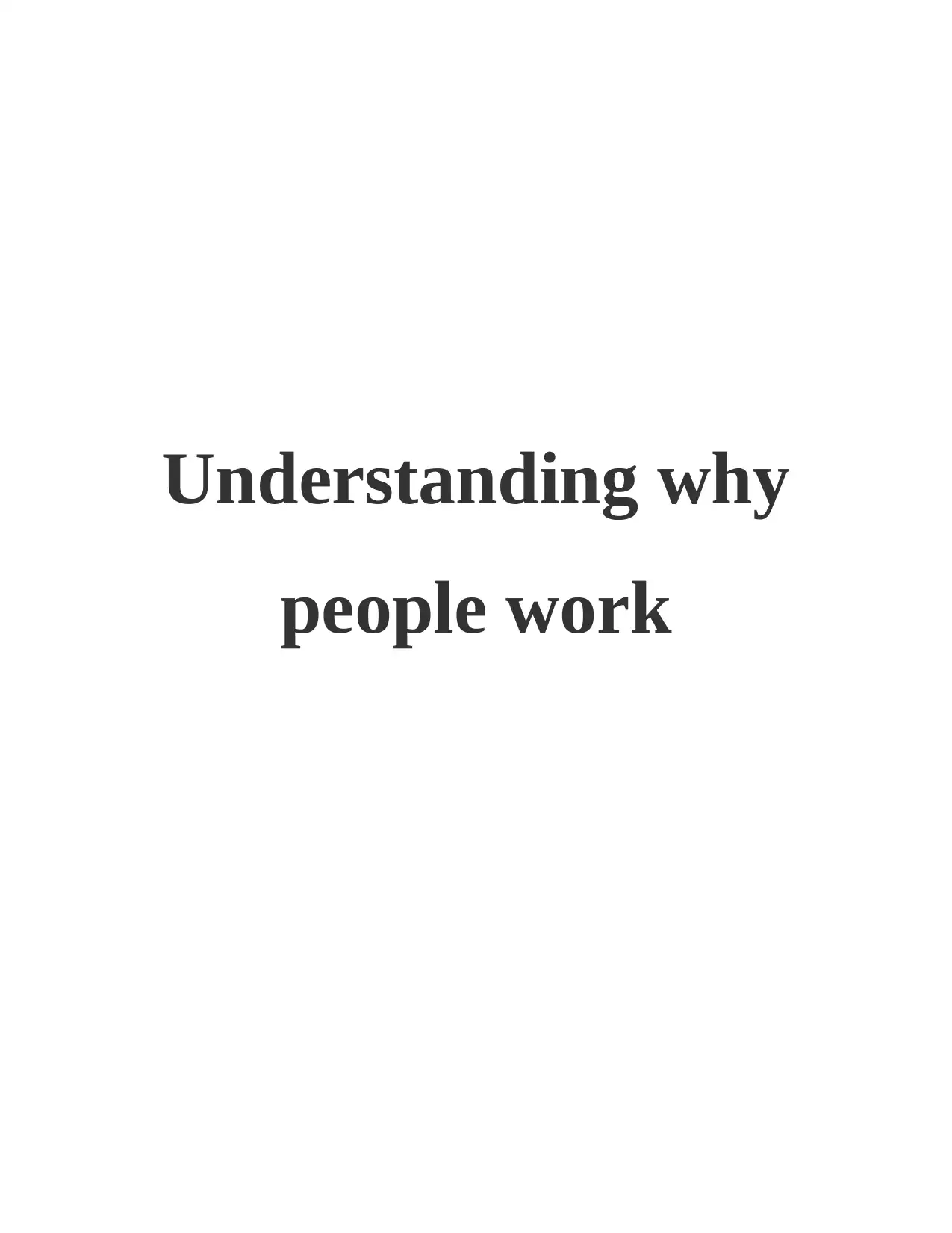
Understanding why
people work
people work
Paraphrase This Document
Need a fresh take? Get an instant paraphrase of this document with our AI Paraphraser
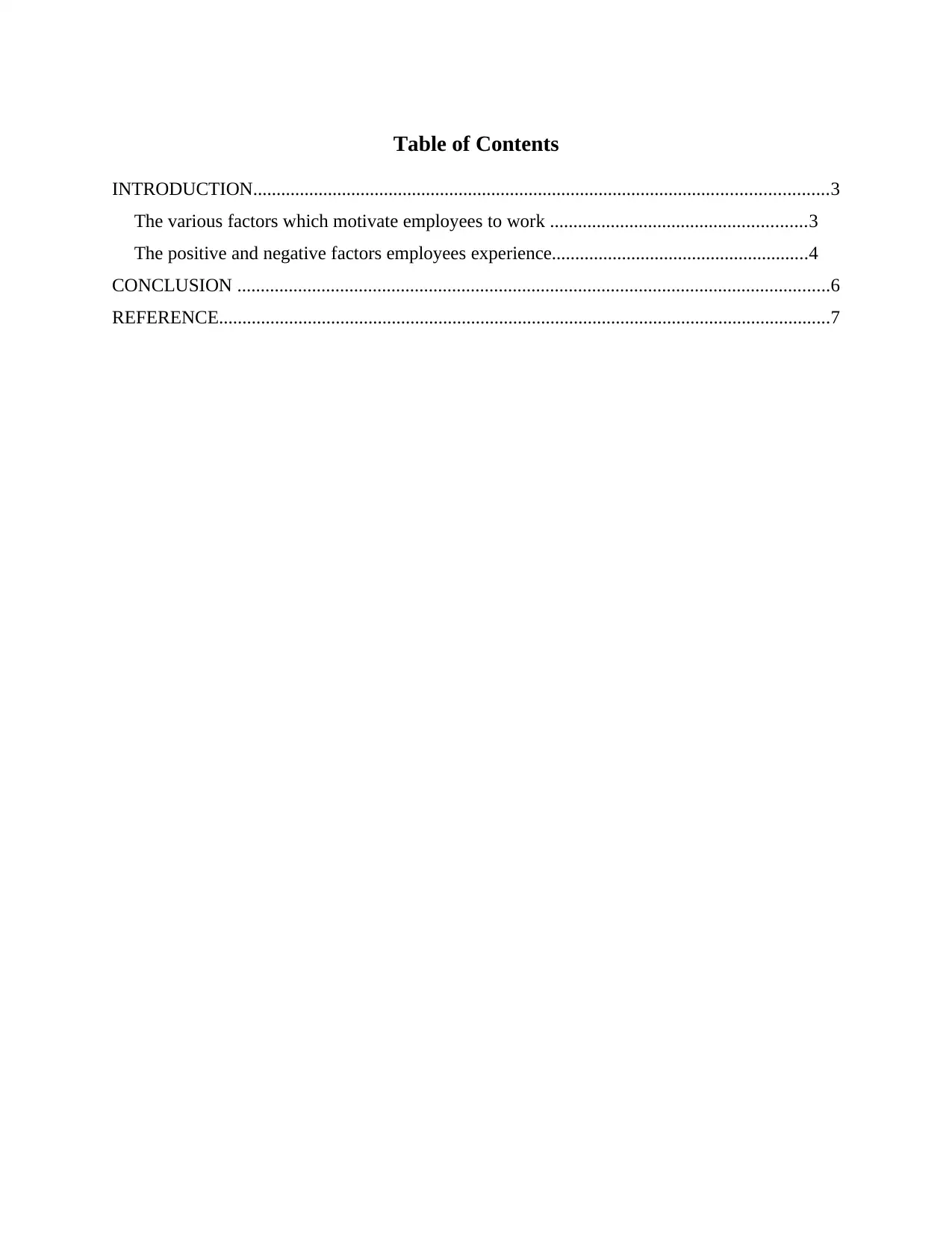
Table of Contents
INTRODUCTION...........................................................................................................................3
The various factors which motivate employees to work .......................................................3
The positive and negative factors employees experience.......................................................4
CONCLUSION ...............................................................................................................................6
REFERENCE...................................................................................................................................7
INTRODUCTION...........................................................................................................................3
The various factors which motivate employees to work .......................................................3
The positive and negative factors employees experience.......................................................4
CONCLUSION ...............................................................................................................................6
REFERENCE...................................................................................................................................7
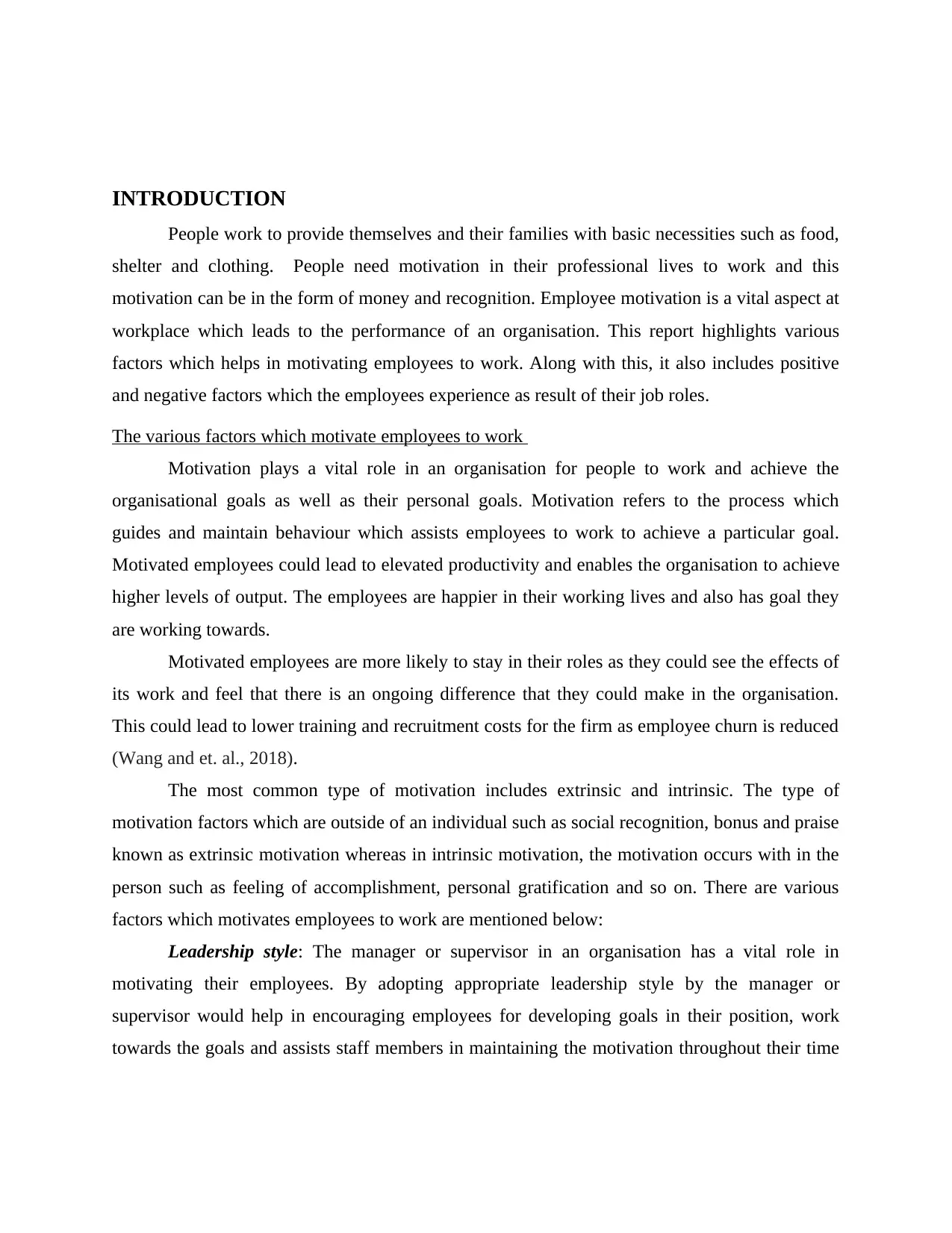
INTRODUCTION
People work to provide themselves and their families with basic necessities such as food,
shelter and clothing. People need motivation in their professional lives to work and this
motivation can be in the form of money and recognition. Employee motivation is a vital aspect at
workplace which leads to the performance of an organisation. This report highlights various
factors which helps in motivating employees to work. Along with this, it also includes positive
and negative factors which the employees experience as result of their job roles.
The various factors which motivate employees to work
Motivation plays a vital role in an organisation for people to work and achieve the
organisational goals as well as their personal goals. Motivation refers to the process which
guides and maintain behaviour which assists employees to work to achieve a particular goal.
Motivated employees could lead to elevated productivity and enables the organisation to achieve
higher levels of output. The employees are happier in their working lives and also has goal they
are working towards.
Motivated employees are more likely to stay in their roles as they could see the effects of
its work and feel that there is an ongoing difference that they could make in the organisation.
This could lead to lower training and recruitment costs for the firm as employee churn is reduced
(Wang and et. al., 2018).
The most common type of motivation includes extrinsic and intrinsic. The type of
motivation factors which are outside of an individual such as social recognition, bonus and praise
known as extrinsic motivation whereas in intrinsic motivation, the motivation occurs with in the
person such as feeling of accomplishment, personal gratification and so on. There are various
factors which motivates employees to work are mentioned below:
Leadership style: The manager or supervisor in an organisation has a vital role in
motivating their employees. By adopting appropriate leadership style by the manager or
supervisor would help in encouraging employees for developing goals in their position, work
towards the goals and assists staff members in maintaining the motivation throughout their time
People work to provide themselves and their families with basic necessities such as food,
shelter and clothing. People need motivation in their professional lives to work and this
motivation can be in the form of money and recognition. Employee motivation is a vital aspect at
workplace which leads to the performance of an organisation. This report highlights various
factors which helps in motivating employees to work. Along with this, it also includes positive
and negative factors which the employees experience as result of their job roles.
The various factors which motivate employees to work
Motivation plays a vital role in an organisation for people to work and achieve the
organisational goals as well as their personal goals. Motivation refers to the process which
guides and maintain behaviour which assists employees to work to achieve a particular goal.
Motivated employees could lead to elevated productivity and enables the organisation to achieve
higher levels of output. The employees are happier in their working lives and also has goal they
are working towards.
Motivated employees are more likely to stay in their roles as they could see the effects of
its work and feel that there is an ongoing difference that they could make in the organisation.
This could lead to lower training and recruitment costs for the firm as employee churn is reduced
(Wang and et. al., 2018).
The most common type of motivation includes extrinsic and intrinsic. The type of
motivation factors which are outside of an individual such as social recognition, bonus and praise
known as extrinsic motivation whereas in intrinsic motivation, the motivation occurs with in the
person such as feeling of accomplishment, personal gratification and so on. There are various
factors which motivates employees to work are mentioned below:
Leadership style: The manager or supervisor in an organisation has a vital role in
motivating their employees. By adopting appropriate leadership style by the manager or
supervisor would help in encouraging employees for developing goals in their position, work
towards the goals and assists staff members in maintaining the motivation throughout their time
⊘ This is a preview!⊘
Do you want full access?
Subscribe today to unlock all pages.

Trusted by 1+ million students worldwide
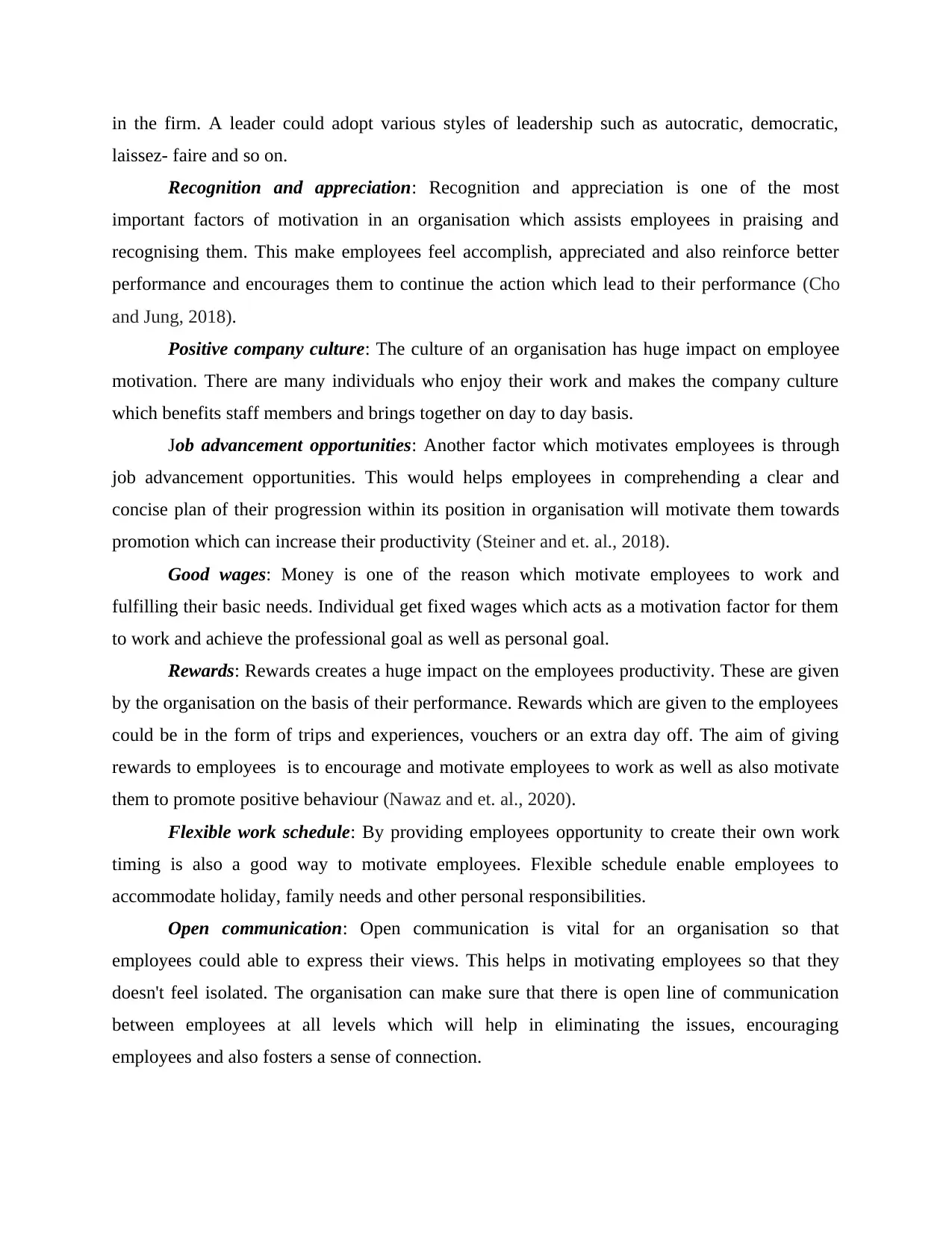
in the firm. A leader could adopt various styles of leadership such as autocratic, democratic,
laissez- faire and so on.
Recognition and appreciation: Recognition and appreciation is one of the most
important factors of motivation in an organisation which assists employees in praising and
recognising them. This make employees feel accomplish, appreciated and also reinforce better
performance and encourages them to continue the action which lead to their performance (Cho
and Jung, 2018).
Positive company culture: The culture of an organisation has huge impact on employee
motivation. There are many individuals who enjoy their work and makes the company culture
which benefits staff members and brings together on day to day basis.
Job advancement opportunities: Another factor which motivates employees is through
job advancement opportunities. This would helps employees in comprehending a clear and
concise plan of their progression within its position in organisation will motivate them towards
promotion which can increase their productivity (Steiner and et. al., 2018).
Good wages: Money is one of the reason which motivate employees to work and
fulfilling their basic needs. Individual get fixed wages which acts as a motivation factor for them
to work and achieve the professional goal as well as personal goal.
Rewards: Rewards creates a huge impact on the employees productivity. These are given
by the organisation on the basis of their performance. Rewards which are given to the employees
could be in the form of trips and experiences, vouchers or an extra day off. The aim of giving
rewards to employees is to encourage and motivate employees to work as well as also motivate
them to promote positive behaviour (Nawaz and et. al., 2020).
Flexible work schedule: By providing employees opportunity to create their own work
timing is also a good way to motivate employees. Flexible schedule enable employees to
accommodate holiday, family needs and other personal responsibilities.
Open communication: Open communication is vital for an organisation so that
employees could able to express their views. This helps in motivating employees so that they
doesn't feel isolated. The organisation can make sure that there is open line of communication
between employees at all levels which will help in eliminating the issues, encouraging
employees and also fosters a sense of connection.
laissez- faire and so on.
Recognition and appreciation: Recognition and appreciation is one of the most
important factors of motivation in an organisation which assists employees in praising and
recognising them. This make employees feel accomplish, appreciated and also reinforce better
performance and encourages them to continue the action which lead to their performance (Cho
and Jung, 2018).
Positive company culture: The culture of an organisation has huge impact on employee
motivation. There are many individuals who enjoy their work and makes the company culture
which benefits staff members and brings together on day to day basis.
Job advancement opportunities: Another factor which motivates employees is through
job advancement opportunities. This would helps employees in comprehending a clear and
concise plan of their progression within its position in organisation will motivate them towards
promotion which can increase their productivity (Steiner and et. al., 2018).
Good wages: Money is one of the reason which motivate employees to work and
fulfilling their basic needs. Individual get fixed wages which acts as a motivation factor for them
to work and achieve the professional goal as well as personal goal.
Rewards: Rewards creates a huge impact on the employees productivity. These are given
by the organisation on the basis of their performance. Rewards which are given to the employees
could be in the form of trips and experiences, vouchers or an extra day off. The aim of giving
rewards to employees is to encourage and motivate employees to work as well as also motivate
them to promote positive behaviour (Nawaz and et. al., 2020).
Flexible work schedule: By providing employees opportunity to create their own work
timing is also a good way to motivate employees. Flexible schedule enable employees to
accommodate holiday, family needs and other personal responsibilities.
Open communication: Open communication is vital for an organisation so that
employees could able to express their views. This helps in motivating employees so that they
doesn't feel isolated. The organisation can make sure that there is open line of communication
between employees at all levels which will help in eliminating the issues, encouraging
employees and also fosters a sense of connection.
Paraphrase This Document
Need a fresh take? Get an instant paraphrase of this document with our AI Paraphraser
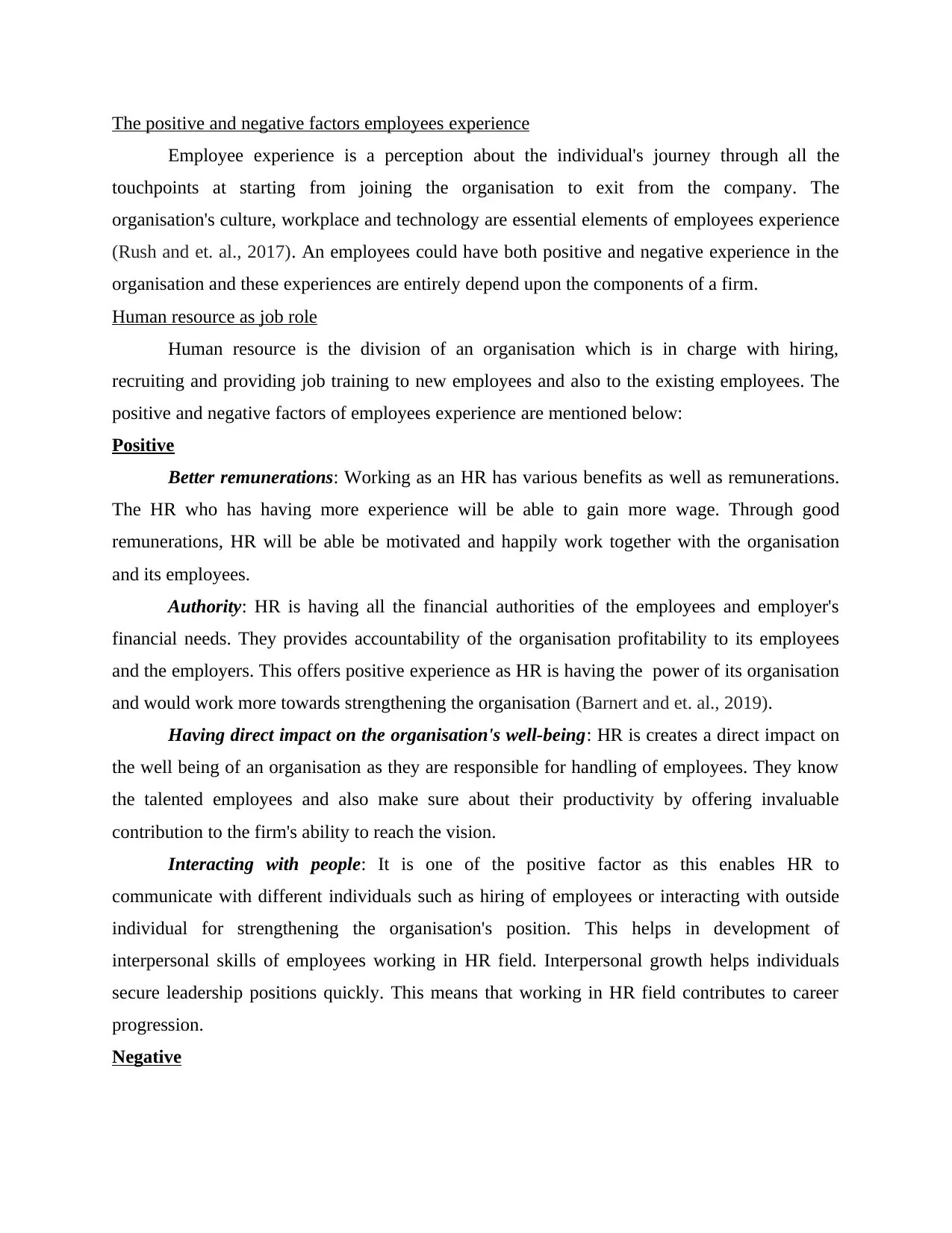
The positive and negative factors employees experience
Employee experience is a perception about the individual's journey through all the
touchpoints at starting from joining the organisation to exit from the company. The
organisation's culture, workplace and technology are essential elements of employees experience
(Rush and et. al., 2017). An employees could have both positive and negative experience in the
organisation and these experiences are entirely depend upon the components of a firm.
Human resource as job role
Human resource is the division of an organisation which is in charge with hiring,
recruiting and providing job training to new employees and also to the existing employees. The
positive and negative factors of employees experience are mentioned below:
Positive
Better remunerations: Working as an HR has various benefits as well as remunerations.
The HR who has having more experience will be able to gain more wage. Through good
remunerations, HR will be able be motivated and happily work together with the organisation
and its employees.
Authority: HR is having all the financial authorities of the employees and employer's
financial needs. They provides accountability of the organisation profitability to its employees
and the employers. This offers positive experience as HR is having the power of its organisation
and would work more towards strengthening the organisation (Barnert and et. al., 2019).
Having direct impact on the organisation's well-being: HR is creates a direct impact on
the well being of an organisation as they are responsible for handling of employees. They know
the talented employees and also make sure about their productivity by offering invaluable
contribution to the firm's ability to reach the vision.
Interacting with people: It is one of the positive factor as this enables HR to
communicate with different individuals such as hiring of employees or interacting with outside
individual for strengthening the organisation's position. This helps in development of
interpersonal skills of employees working in HR field. Interpersonal growth helps individuals
secure leadership positions quickly. This means that working in HR field contributes to career
progression.
Negative
Employee experience is a perception about the individual's journey through all the
touchpoints at starting from joining the organisation to exit from the company. The
organisation's culture, workplace and technology are essential elements of employees experience
(Rush and et. al., 2017). An employees could have both positive and negative experience in the
organisation and these experiences are entirely depend upon the components of a firm.
Human resource as job role
Human resource is the division of an organisation which is in charge with hiring,
recruiting and providing job training to new employees and also to the existing employees. The
positive and negative factors of employees experience are mentioned below:
Positive
Better remunerations: Working as an HR has various benefits as well as remunerations.
The HR who has having more experience will be able to gain more wage. Through good
remunerations, HR will be able be motivated and happily work together with the organisation
and its employees.
Authority: HR is having all the financial authorities of the employees and employer's
financial needs. They provides accountability of the organisation profitability to its employees
and the employers. This offers positive experience as HR is having the power of its organisation
and would work more towards strengthening the organisation (Barnert and et. al., 2019).
Having direct impact on the organisation's well-being: HR is creates a direct impact on
the well being of an organisation as they are responsible for handling of employees. They know
the talented employees and also make sure about their productivity by offering invaluable
contribution to the firm's ability to reach the vision.
Interacting with people: It is one of the positive factor as this enables HR to
communicate with different individuals such as hiring of employees or interacting with outside
individual for strengthening the organisation's position. This helps in development of
interpersonal skills of employees working in HR field. Interpersonal growth helps individuals
secure leadership positions quickly. This means that working in HR field contributes to career
progression.
Negative
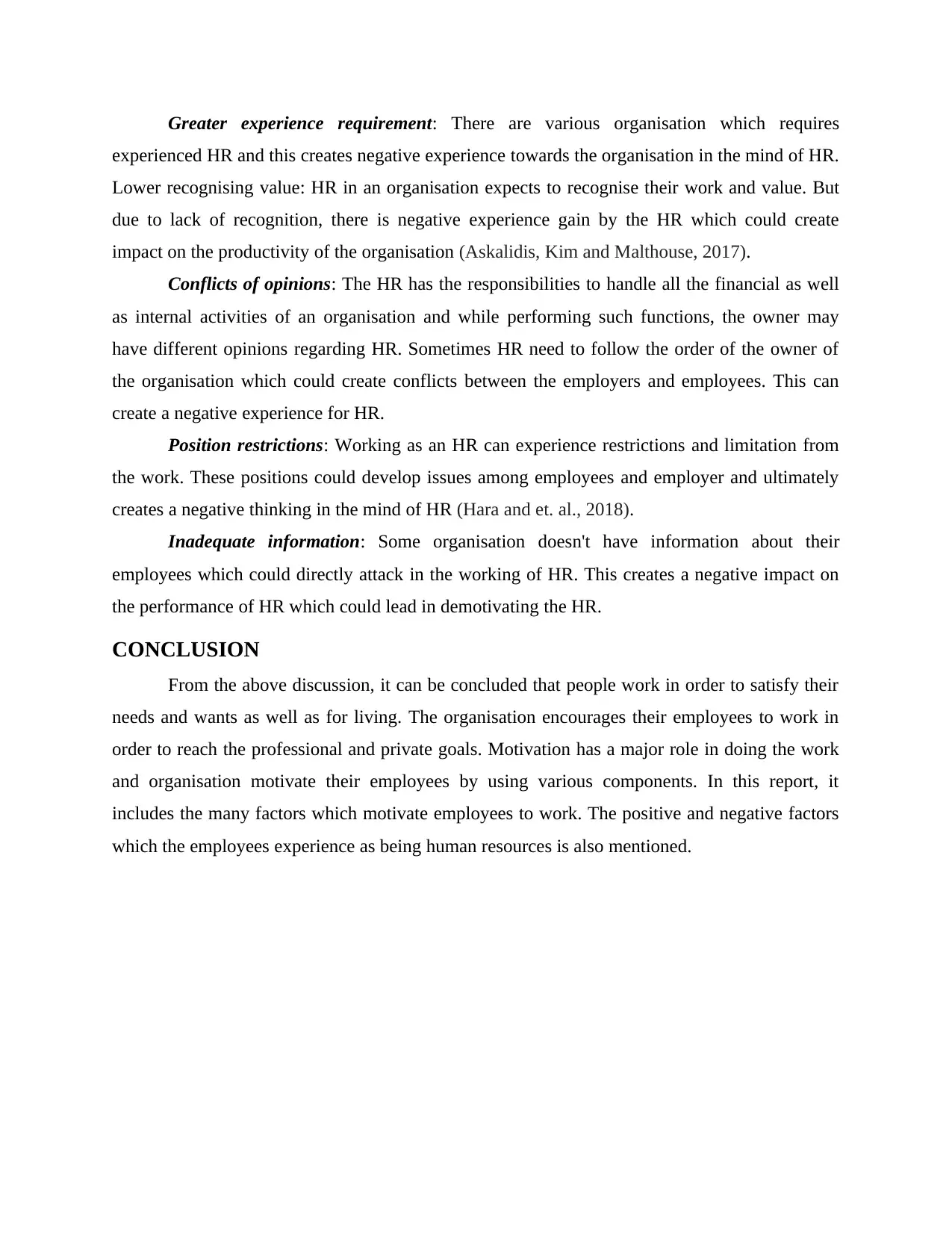
Greater experience requirement: There are various organisation which requires
experienced HR and this creates negative experience towards the organisation in the mind of HR.
Lower recognising value: HR in an organisation expects to recognise their work and value. But
due to lack of recognition, there is negative experience gain by the HR which could create
impact on the productivity of the organisation (Askalidis, Kim and Malthouse, 2017).
Conflicts of opinions: The HR has the responsibilities to handle all the financial as well
as internal activities of an organisation and while performing such functions, the owner may
have different opinions regarding HR. Sometimes HR need to follow the order of the owner of
the organisation which could create conflicts between the employers and employees. This can
create a negative experience for HR.
Position restrictions: Working as an HR can experience restrictions and limitation from
the work. These positions could develop issues among employees and employer and ultimately
creates a negative thinking in the mind of HR (Hara and et. al., 2018).
Inadequate information: Some organisation doesn't have information about their
employees which could directly attack in the working of HR. This creates a negative impact on
the performance of HR which could lead in demotivating the HR.
CONCLUSION
From the above discussion, it can be concluded that people work in order to satisfy their
needs and wants as well as for living. The organisation encourages their employees to work in
order to reach the professional and private goals. Motivation has a major role in doing the work
and organisation motivate their employees by using various components. In this report, it
includes the many factors which motivate employees to work. The positive and negative factors
which the employees experience as being human resources is also mentioned.
experienced HR and this creates negative experience towards the organisation in the mind of HR.
Lower recognising value: HR in an organisation expects to recognise their work and value. But
due to lack of recognition, there is negative experience gain by the HR which could create
impact on the productivity of the organisation (Askalidis, Kim and Malthouse, 2017).
Conflicts of opinions: The HR has the responsibilities to handle all the financial as well
as internal activities of an organisation and while performing such functions, the owner may
have different opinions regarding HR. Sometimes HR need to follow the order of the owner of
the organisation which could create conflicts between the employers and employees. This can
create a negative experience for HR.
Position restrictions: Working as an HR can experience restrictions and limitation from
the work. These positions could develop issues among employees and employer and ultimately
creates a negative thinking in the mind of HR (Hara and et. al., 2018).
Inadequate information: Some organisation doesn't have information about their
employees which could directly attack in the working of HR. This creates a negative impact on
the performance of HR which could lead in demotivating the HR.
CONCLUSION
From the above discussion, it can be concluded that people work in order to satisfy their
needs and wants as well as for living. The organisation encourages their employees to work in
order to reach the professional and private goals. Motivation has a major role in doing the work
and organisation motivate their employees by using various components. In this report, it
includes the many factors which motivate employees to work. The positive and negative factors
which the employees experience as being human resources is also mentioned.
⊘ This is a preview!⊘
Do you want full access?
Subscribe today to unlock all pages.

Trusted by 1+ million students worldwide
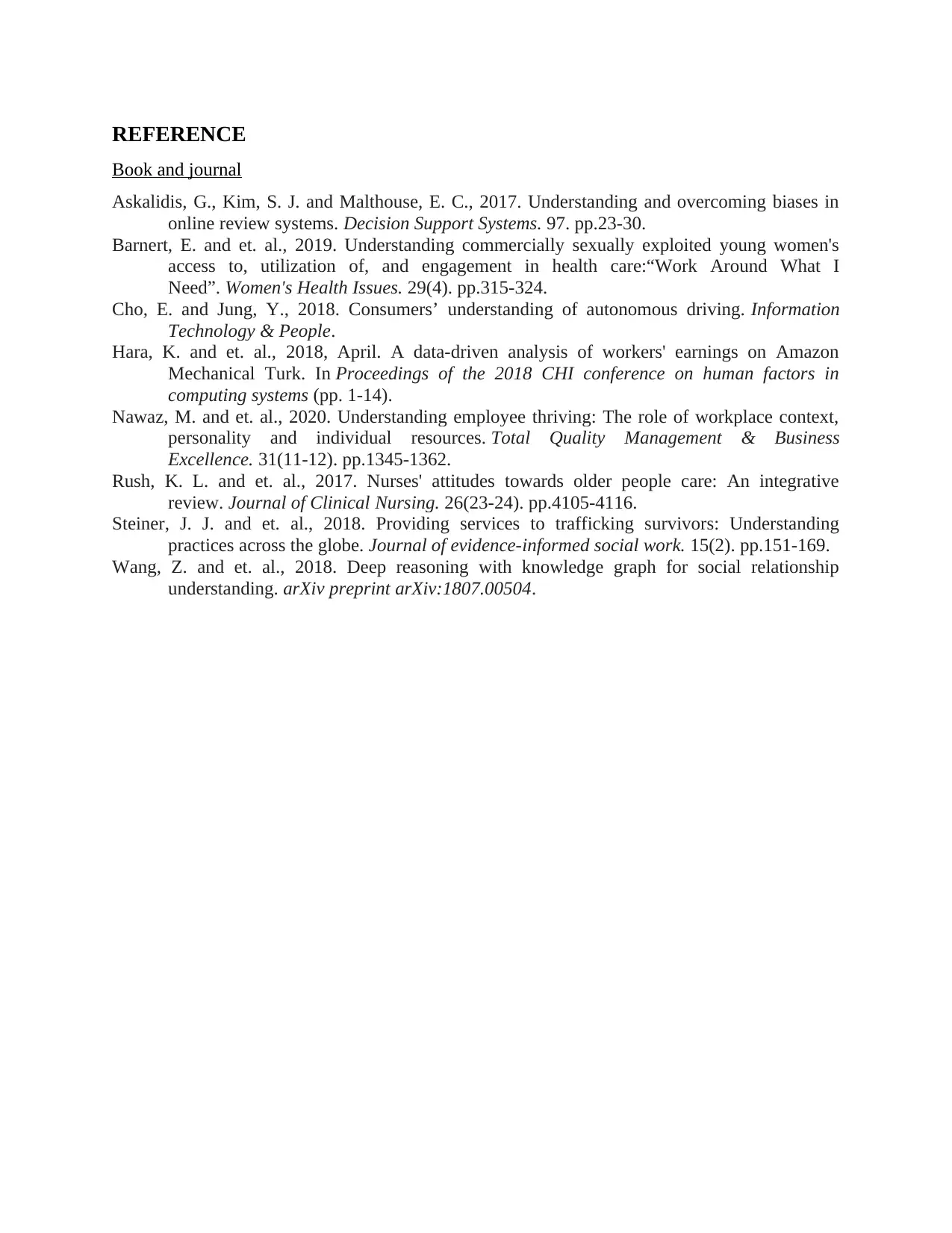
REFERENCE
Book and journal
Askalidis, G., Kim, S. J. and Malthouse, E. C., 2017. Understanding and overcoming biases in
online review systems. Decision Support Systems. 97. pp.23-30.
Barnert, E. and et. al., 2019. Understanding commercially sexually exploited young women's
access to, utilization of, and engagement in health care:“Work Around What I
Need”. Women's Health Issues. 29(4). pp.315-324.
Cho, E. and Jung, Y., 2018. Consumers’ understanding of autonomous driving. Information
Technology & People.
Hara, K. and et. al., 2018, April. A data-driven analysis of workers' earnings on Amazon
Mechanical Turk. In Proceedings of the 2018 CHI conference on human factors in
computing systems (pp. 1-14).
Nawaz, M. and et. al., 2020. Understanding employee thriving: The role of workplace context,
personality and individual resources. Total Quality Management & Business
Excellence. 31(11-12). pp.1345-1362.
Rush, K. L. and et. al., 2017. Nurses' attitudes towards older people care: An integrative
review. Journal of Clinical Nursing. 26(23-24). pp.4105-4116.
Steiner, J. J. and et. al., 2018. Providing services to trafficking survivors: Understanding
practices across the globe. Journal of evidence-informed social work. 15(2). pp.151-169.
Wang, Z. and et. al., 2018. Deep reasoning with knowledge graph for social relationship
understanding. arXiv preprint arXiv:1807.00504.
Book and journal
Askalidis, G., Kim, S. J. and Malthouse, E. C., 2017. Understanding and overcoming biases in
online review systems. Decision Support Systems. 97. pp.23-30.
Barnert, E. and et. al., 2019. Understanding commercially sexually exploited young women's
access to, utilization of, and engagement in health care:“Work Around What I
Need”. Women's Health Issues. 29(4). pp.315-324.
Cho, E. and Jung, Y., 2018. Consumers’ understanding of autonomous driving. Information
Technology & People.
Hara, K. and et. al., 2018, April. A data-driven analysis of workers' earnings on Amazon
Mechanical Turk. In Proceedings of the 2018 CHI conference on human factors in
computing systems (pp. 1-14).
Nawaz, M. and et. al., 2020. Understanding employee thriving: The role of workplace context,
personality and individual resources. Total Quality Management & Business
Excellence. 31(11-12). pp.1345-1362.
Rush, K. L. and et. al., 2017. Nurses' attitudes towards older people care: An integrative
review. Journal of Clinical Nursing. 26(23-24). pp.4105-4116.
Steiner, J. J. and et. al., 2018. Providing services to trafficking survivors: Understanding
practices across the globe. Journal of evidence-informed social work. 15(2). pp.151-169.
Wang, Z. and et. al., 2018. Deep reasoning with knowledge graph for social relationship
understanding. arXiv preprint arXiv:1807.00504.
1 out of 7
Related Documents
Your All-in-One AI-Powered Toolkit for Academic Success.
+13062052269
info@desklib.com
Available 24*7 on WhatsApp / Email
![[object Object]](/_next/static/media/star-bottom.7253800d.svg)
Unlock your academic potential
Copyright © 2020–2025 A2Z Services. All Rights Reserved. Developed and managed by ZUCOL.




